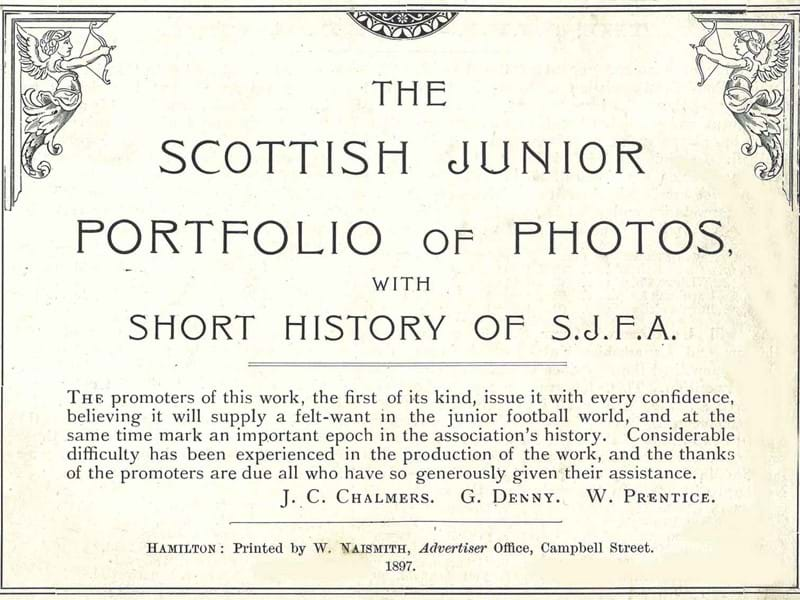Scottish Junior Portfolio

The Scottish Junior Portfolio of Photos was published in 1897 by J.C. Chalmers, G. Denny and W. Prentice. It included a short retrospect of the first eleven years of junior football, as well as an extensive library of pictures. The book was supplied by the Scottish Football Museum and has been digitised. The content is shown below.
THE S.J.F.A. - A RETROSPECT.
THE value of a correct record of the Scottish Junior Football Association can only be truly estimated by those who have an appetite for facts and figures, and are imbued with that enthusiasm which has played such a prominent part in junior football. In giving a brief sketch Of the work performed since its institution in 1886 we acknowledge our indebtedness to the able succession of secretaries and officials who have, (from year to year, piloted the Association to the goal of success. It is worthy of note that in 1886 the membership was only 39, but has since then flourished like Jacob's mushroom, and is presently 170, or fully thirty ahead of the senior body. The early days were in very many respects the halcyon days amongst juniors, but only want of space prevents us giving a detailed account of the many stirring struggles for the Blue Ribbon. However, the following statistics may serve to furnish some idea of the past cupholders.

As will be observed from the foregoing, Glasgow and Lanarkshire clubs have between them monopolised the cup since the inception of the competition. This, however, is not to be wondered at, when it is taken into account that for many years their combined membership was equal 'to two-thirds of the total, but recently this proportion has lessened to one-third owing to the increase in Ayrshire, Renfrewshire, and the Northern districts. In the early days the great majority of the clubs had no means of gate drawings, and were, therefore, dependent on the private subscriptions of their members and patrons. The keen struggles for the national trophy soon brought out many players of sterling merit, who were in after years destined to figure prominently in defending their country's honour, and of those who have reached the pinnacle of greatness may be mentioned

The work of the Association has been steadily increasing, but it has only been during the past four years that the increase has been so pronounced as to arrest the attention of the seniors. While remarkable headway has been made by the Association, the clubs have also flourished, and it is safe to say their revenue at present equals that of many of the senior clubs in the eighties. Leading combinations have now the same facilities for training, with ground accommodation, as many seniors, and further improvements in this direction clearly indicate that the juniors are a band of progressives. The work of the Association has hitherto been discharged by a general committee, but this has lately been found impracticable, and sub-committees now take over some of the work, a step that has been justified by the success of these committees.
International Intercourse.
The first International with Ireland, as every votary of the game knows, resulted in a victory for Scotland, This, however, proved their only runaway victory over the representatives of the Emerald Isle. Ireland has gradually crept up much closer, and in the second year, at Ireland, it was only the brilliant form of Cullen (Benburb), Sinclair (Minerva), and Gosling (Ibrox X I.) that saved defeat, the game ending in a draw—2 each. Since then Scotland has always gained the mastery, but while flattering ourselves that we have not vet tasted the bitterness of defeat from Ireland, recent Internationals have forced home the fact that Ireland is 'steadily improving, and, as they annually remind us, "It's a long lane that hasn't a turning." Following are the results :

It was in 1895, and chiefly through the efforts of Mr Wm. Reid, then secretary, that negotiations were entered upon with Birmingham and District Association, an association that not only has as large a membership, but also covers as wide an area as that of our own Association. The first encounter was played at Leamington that year, and England, who were represented by some spartan-like trundlers, administered our first International reverse. The courtesy meted out by the Englishmen has been productive of good results, and this has been established an annual fixture. On the second meeting the game was played at Kelburn Park, where a record gate, namely £69, was secured, and Scotland, through the phenominal goalkeeping of O'Brien (Mossend Brigade), won by 6 to 5, and in a sense 'the previous defeat was avenged. The third game was played at Perry Bar, Birmingham, and Scotland's chosen were undoubtedly that year the " creme de la creme " of junior football, and after a brilliant display won by 4 to 0. The fourth game created a record that may stand for a considerable period with regard to the amount drawn at the gate, viz., £275, but again England gained the mastery, winning on Celtic Park by 4 to 3.


























































































































